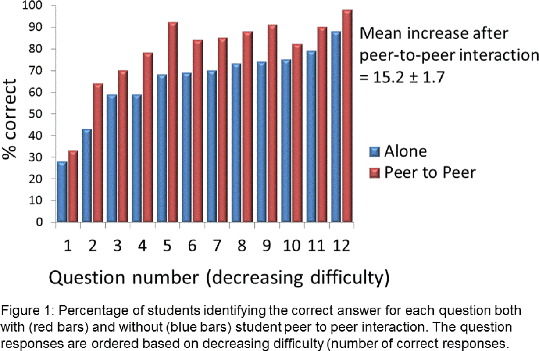Print version
Search Pub Med
| 082P London, UK Pharmacology 2017 |
The power of peer to peer learning within a traditional lecture based pharmacology course
Background and Aims: The lecture remains one of the primary and most cost effective ways of teaching university students enrolled on large courses. However, cognitive science indicates that human short term memory is limited and can only process so much information at once. As a result, lecture based courses tend to encourage students to passively absorb information and subsequently learn through rote-memorization. The challenge for the lecturer is to introduce activities that encourage students to engage with, and develop an understanding of the material being taught. Peer to peer learning within the large lecture offers the opportunity for students to compare their understanding and learn from each other (1). The aim of this study was to demonstrate the effectiveness of peer to peer learning within a large lecture.
Summary of work and outcomes: The lectures within a Year 2 Pharmacology course include multiple choice questions to test understanding. An audience response system (mentimeter) is utilised to visualise student responses. Students (n= 200+) are asked to submit choices without peer interaction (i.e. in silence), and subsequently allowed to resubmit their choices after discussing their answer with their peers. Students are then shown the responses, before and after peer-to-peer interaction. Student responses to twelve multiple choice questions were analysed. Without peer interaction, the mean percentage of students identifying the correct answer was 65.4%, whereas peer-to-peer interaction increased the mean percentage to 79.6% - see Figure 1.$$

Discussion: Inclusion of multiple choice questions during the lecture allowed students to consolidate material submitted to short term memory. The peer instruction model was introduced by Mazur (2) and is now a common approach within education. Our data demonstrate that peer-to-peer interaction can be facilitated within a large lecture class and the use of an audience response system enables individual lecturers to utilise this method. This method ensures that many more students choose the right answer after they have talked to their peers and thus increases student understanding.
Conclusion: The combination of audience response software with peer to peer learning during lectures throughout the course has the potential to encourage a deeper understanding of fundamental concepts, and this is applicable across disciplines.
References:
1. Sampson, J & Cohen, R (2001). Designing peer learning. In Boud, D., Cohen, R. & Sampson, J. (Ed), Peer learning in higher education. Kogan Page.
2. Mazur E (1997). In: Mazur E (ed). Peer Instruction: A User's Manual. Prentice Hall: Upper Saddle River, NJ.

